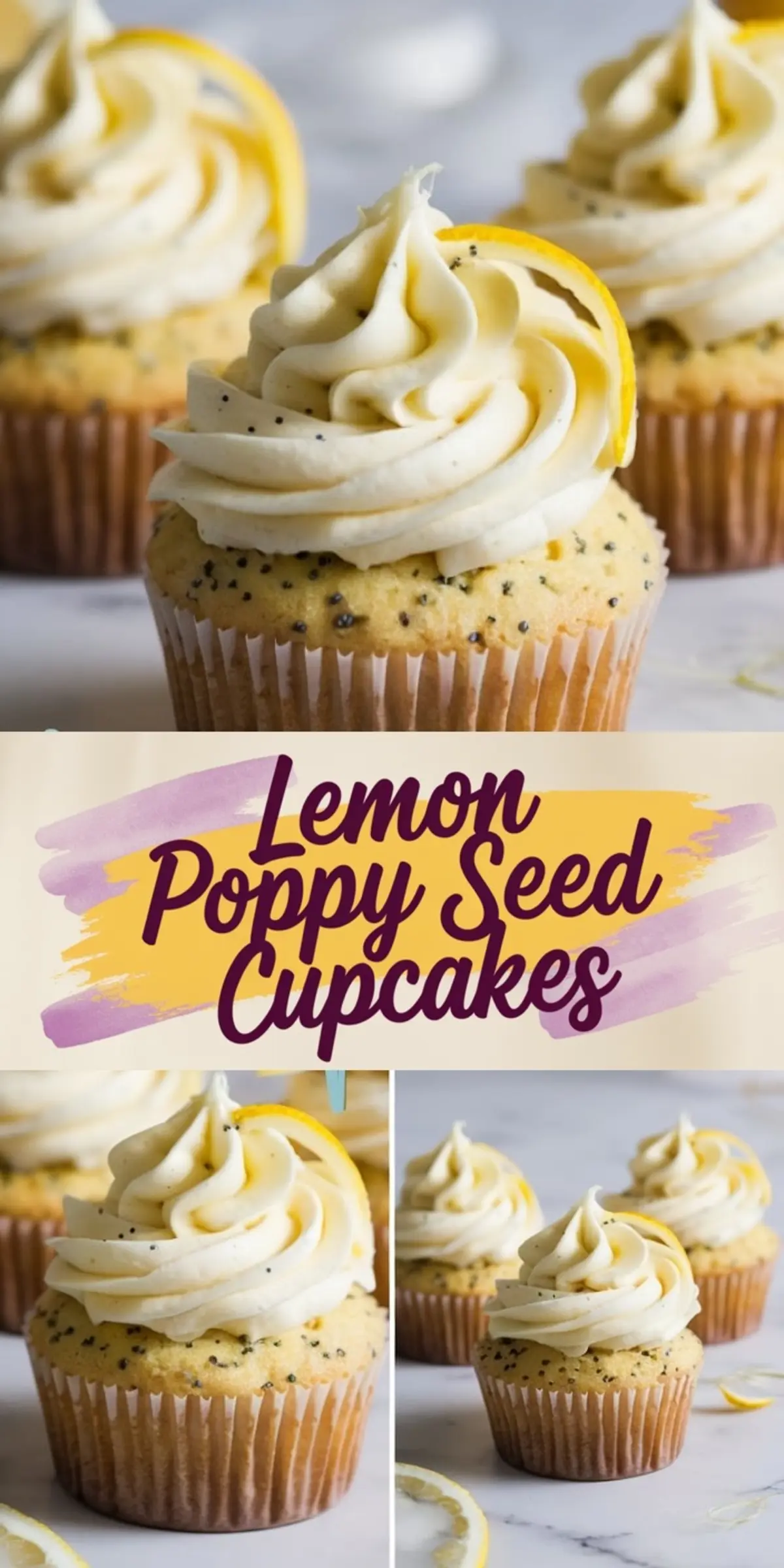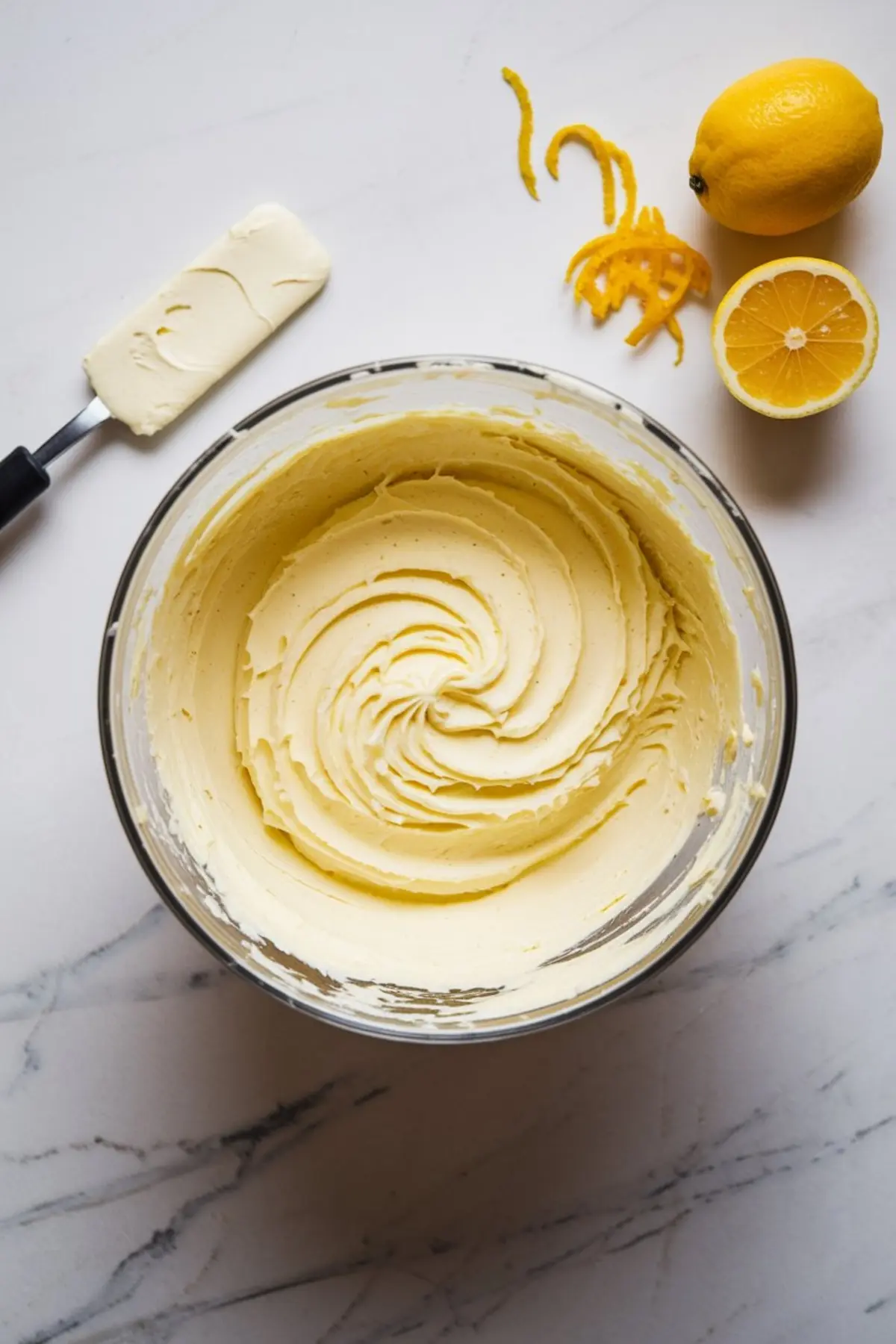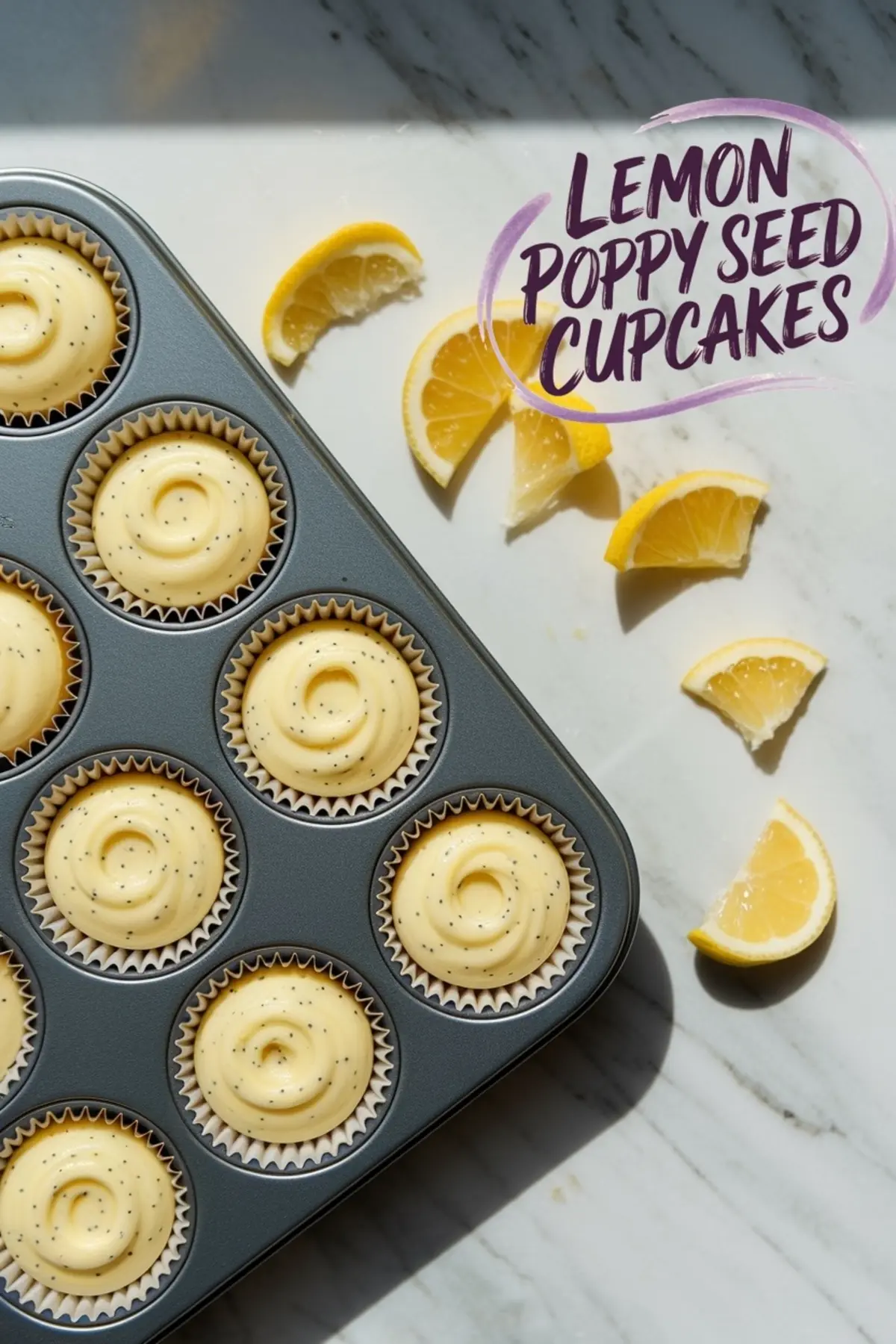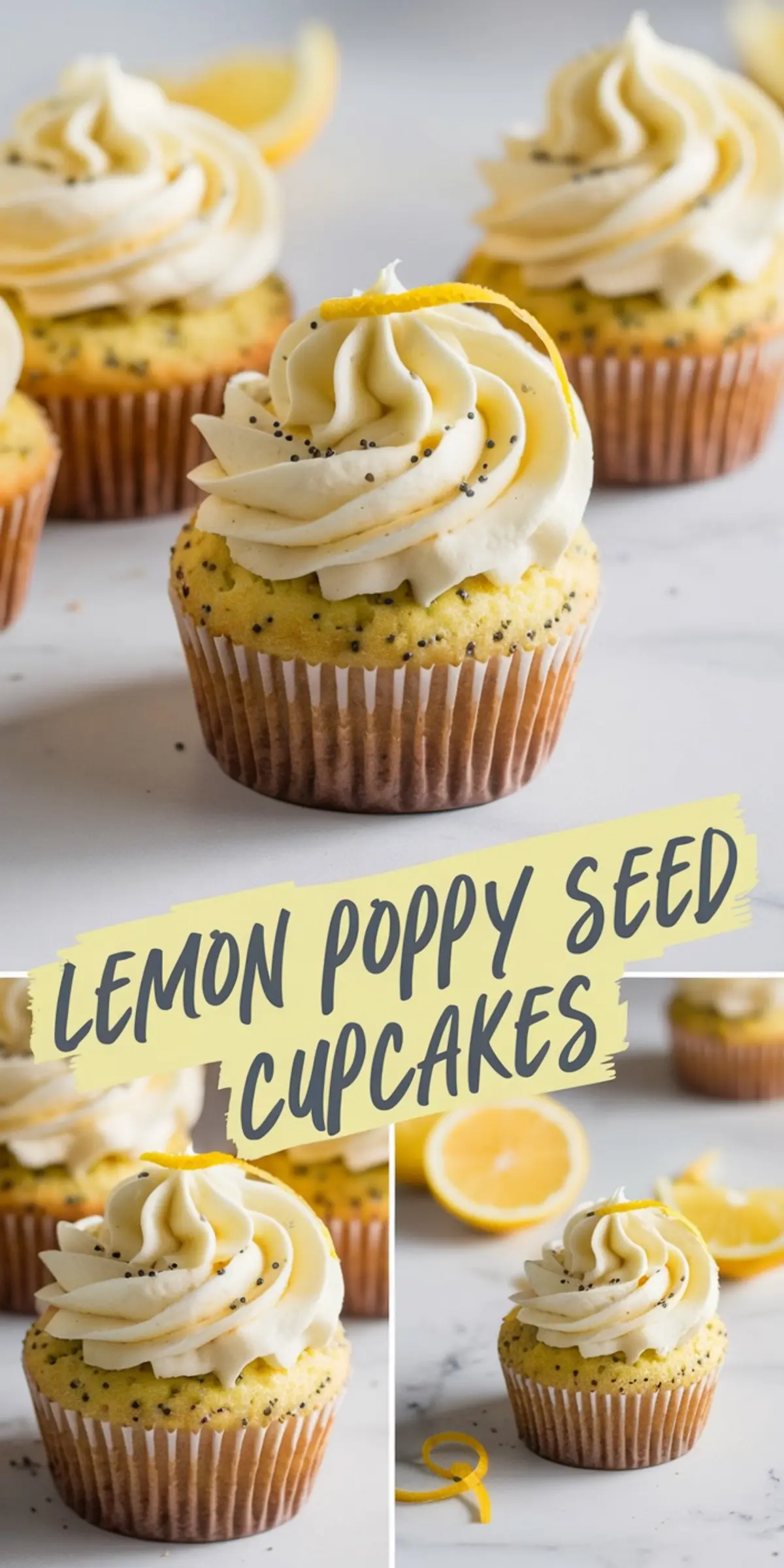These cupcakes deliver a soft crumb that tastes fresh and inviting. Poppy seeds add a playful texture that distinguishes them from standard lemon bakes. The citrus factor hits a sweet spot that suits casual snacks or small celebrations.
I often bake a batch for lazy weekend afternoons. Neighborhood kids appear when the aroma drifts through an open window. My family hovers around the cooling rack, waiting for the frosting to go on.
A single bite feels bright and satisfying. The tang rests gently on your tongue. A smooth buttercream swirls on top, transforming each cupcake into a little indulgence.

Mixing a Smooth Cupcake Batter
Flour, baking powder, salt, and poppy seeds form the base in one bowl. Butter and sugar meet in another bowl for a creamy blend that boosts a tender result. Eggs join one at a time so they blend well.

Lemon zest and juice follow, which elevates the flavor from mild to vibrant. A bit of milk helps loosen the batter. Vanilla slides in as a finishing note.
A short mixing session is enough to combine everything. Overbeating may produce a dense crumb. Most folks prefer these cupcakes light and airy.

Baking Steps for Optimal Results
Preheated ovens ensure steady heat distribution. Cupcake liners keep each portion neat, which makes cleanup simpler. Batter fills each cup about three-quarters to reduce spill risk.
I check for doneness around 18 minutes. A toothpick test works best: if it emerges with no wet batter, the cupcakes are ready. A short rest in the tin helps them settle before transferring to a rack.

Friends sometimes ask why the tops brown too fast. A loose foil tent prevents excess browning during those final minutes. That helps maintain a pale, lemony exterior.
Lemon Buttercream That Complements Every Bite
Softened butter beats until creamy. Powdered sugar trickles in gradually, helping you avoid lumps. A bright punch of lemon zest and juice enhances the tang.
I add a small splash of heavy cream if the frosting needs a smoother texture. A few final whips make it fluffy. Vanilla rounds out the taste and ties the frosting to the cupcake crumb.
A piping bag with a star tip forms those classic swirls. An offset spatula works just as well if you prefer a simpler approach. A light dusting of extra poppy seeds can finish the look.
Personal Touches and Taste Variations
Some bakers brush lemon syrup on warm cupcakes. That approach highlights the citrus. My friend tried chia seeds instead of poppy seeds for a similar effect.
Almond milk can replace regular milk if dairy poses a concern. Another friend swapped vanilla extract for almond extract and reported a nuttier undertone. These tweaks allow a bit of creativity without losing the original theme.
A cousin once made a batch without seeds. She missed the crunch but still loved the lemon essence. There is always room for experimentation if you keep the core ratios intact.
Keeping the Citrus Theme Going with Other Recipes
Lemon Fudge offers a mellow sweetness. That no-bake option helps on busy days. It remains a top choice among my family because of its creamy texture.
Mini Lemon Tarts deliver a tart layer in a crispy shell. They fit formal gatherings or casual picnics. My neighbor once brought them to a community potluck, and not a crumb remained.
Lemon Buttercream Cupcakes also appear on the site. That recipe shares similarities but focuses on a classic approach. You can compare both methods and decide which suits your style.
Serving Ideas That Appeal to Guests
Cupcakes shine on a dessert table next to fresh fruits or savory snacks. They even spark conversation at brunches with friends. Some people serve them with warm tea or iced coffee for contrast.
Bright colors on the frosting entice kids who see them from across the room. Grown-ups appreciate the refined taste that balances sweet notes with citrus. Everyone wins when a platter of these cupcakes arrives.
Leftover cupcakes rarely remain. People often grab a second or third. This is the kind of recipe that keeps a crowd happy.
Storing and Planning Ahead
An airtight container guards freshness for a couple of days at room temperature. The fridge extends their life up to five days, but let them reach room temperature before serving. That final step brings back their softness.
A freezer approach works for big events. Freeze unfrosted cupcakes in one layer so they don’t stick together. Thaw them and swirl buttercream on top at your convenience.
Leftover frosting also keeps well in the freezer. A quick re-whip revives its spreadable form. This method helps if you plan multiple baked goods over a busy weekend.
Pin This Recipe and Share Your Feedback

Lemon poppy seed cupcakes bring a gentle crunch and a zingy finish. You can pin this recipe to your boards and revisit it whenever you crave a citrus boost. Comments about your experience, questions, and personal twists always bring this baking community closer.
I enjoy hearing how each baker personalizes these cupcakes. That connection inspires me to experiment with fresh ideas. There is always something new to learn from each shared tip.
Feel free to explore other lemon recipes if this one sparks further interest. I look forward to reading your thoughts. Your stories help keep baking vibrant and creative for everyone.
Lemon Poppy Seed Cupcakes with Lemon Buttercream

Soft lemon poppy seed cupcakes with a bright citrus flavor, topped with a creamy lemon buttercream. These cupcakes are moist, tender, and perfect for any lemon lover.
Ingredients
- FOR THE CUPCAKES:
- 1 ½ cups (190g) all-purpose flour
- 1 ½ teaspoons baking powder
- ¼ teaspoon salt
- 2 tablespoons poppy seeds
- ½ cup (115g) unsalted butter, softened
- ¾ cup (150g) granulated sugar
- 2 large eggs
- Zest of 1 lemon
- ¼ cup (60ml) fresh lemon juice
- ½ cup (120ml) whole milk
- 1 teaspoon vanilla extract
- FOR THE LEMON BUTTERCREAM:
- 1 cup (230g) unsalted butter, softened
- 3 ½ cups (440g) powdered sugar
- Zest of 1 lemon
- 2 tablespoons fresh lemon juice
- 1 teaspoon vanilla extract
- 2 tablespoons heavy cream (adjust for consistency)
Instructions
- PREHEAT AND PREPARE: Preheat the oven to 350°F (175°C). Line a 12-cup muffin tin with cupcake liners.
- MIX THE DRY INGREDIENTS: In a medium bowl, whisk together the flour, baking powder, salt, and poppy seeds. Set aside.
- CREAM THE BUTTER AND SUGAR: In a large mixing bowl, beat the butter and sugar together until light and fluffy, about 2-3 minutes.
- ADD EGGS AND FLAVORING: Beat in the eggs, one at a time, ensuring each is well incorporated. Add the lemon zest, lemon juice, and vanilla extract.
- COMBINE WET AND DRY: Alternately add the dry ingredients and milk to the butter mixture, starting and ending with the dry ingredients. Mix until just combined—do not overmix.
- BAKE: Divide the batter evenly among the cupcake liners, filling each about ¾ full. Bake for 18-20 minutes or until a toothpick inserted into the center comes out clean.
- COOL: Let the cupcakes cool in the pan for 5 minutes, then transfer them to a wire rack to cool completely before frosting.
- BEAT THE BUTTER: In a large bowl, beat the butter until smooth and creamy, about 2 minutes.
- ADD SUGAR AND FLAVORING: Gradually add the powdered sugar, one cup at a time, beating well after each addition. Add the lemon zest, lemon juice, and vanilla extract.
- ADJUST CONSISTENCY: Add heavy cream, one tablespoon at a time, until the frosting is smooth and pipeable. Beat for another 2-3 minutes until fluffy.
- FROST THE CUPCAKES: Using a piping bag fitted with a star tip, swirl the buttercream onto each cupcake. Garnish with extra poppy seeds or a lemon slice.
Notes
For the best texture, ensure all ingredients are at room temperature before starting. This helps the batter mix more evenly, resulting in soft and fluffy cupcakes.
When measuring flour, use the spoon-and-level method rather than scooping directly from the bag. This prevents excess flour from making the cupcakes dense.
Do not overmix the batter once the dry ingredients are added. Overmixing can develop too much gluten, leading to a tougher texture. Stir just until the ingredients are combined.
To check for doneness, insert a toothpick into the center of a cupcake. If it comes out clean or with just a few moist crumbs, they are done. If wet batter clings to the toothpick, bake for an additional 1-2 minutes before testing again.
If the cupcakes are browning too quickly, tent a piece of aluminum foil loosely over the muffin tin during the last few minutes of baking.
Allow the cupcakes to cool completely before frosting. If they are warm, the buttercream may melt and lose its shape.
For extra lemon flavor, brush the tops of the warm cupcakes with a light layer of lemon syrup made from equal parts sugar and fresh lemon juice. Let it soak in before frosting.
When making the buttercream, sift the powdered sugar before adding it to the butter. This helps create a smoother, lump-free frosting.
Adjust the consistency of the buttercream by adding more heavy cream for a softer texture or more powdered sugar for a firmer texture. If the frosting becomes too soft, refrigerate it for 10-15 minutes before piping.
For piping, use a large open star or round tip for a professional look. If you do not have a piping bag, spread the frosting with an offset spatula or butter knife.
Store cupcakes in an airtight container at room temperature for up to 2 days or refrigerate for up to 5 days. Bring refrigerated cupcakes to room temperature before serving to enhance flavor and texture.
Cupcakes can be frozen for up to 3 months. Freeze unfrosted cupcakes in a single layer on a baking sheet, then transfer them to a sealed container. Thaw at room temperature before frosting. Buttercream can also be frozen separately in an airtight container and re-whipped before using.
For a variation, replace the poppy seeds with chia seeds or omit them for a smooth lemon cupcake. You can also substitute almond or coconut milk for the whole milk for a slightly different flavor profile.
Nutrition Information
Yield
12Serving Size
1Amount Per Serving Calories 117Total Fat 4gSaturated Fat 2gTrans Fat 0gUnsaturated Fat 2gCholesterol 38mgSodium 135mgCarbohydrates 17gFiber 1gSugar 3gProtein 4g

